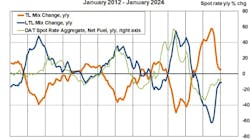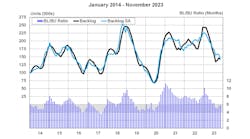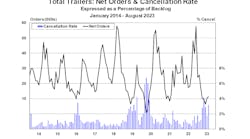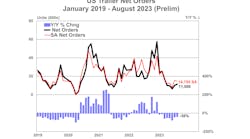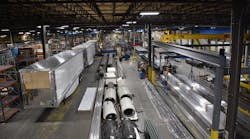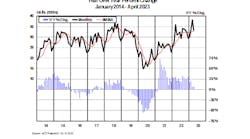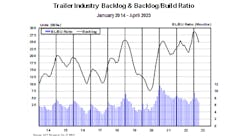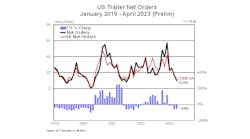Research firm FTR Transportation Intelligence continues to forecast a “tough year” for shippers in terms of truck capacity and freight rates as the company’s Shippers Conditions Index (SCI) score in January bottomed out at a negative 11.1. And tough conditions for shippers should translate to a continued upswing in equipment demand—and the cash flow to support it—for carriers.
Freight rate growth year-over-year is expected to accelerate in the second quarter before easing slightly in the second half of 2018, FTR said. But the full enforcement of the electronic logging device (ELD) mandate expected to start April 1 combined with an ongoing driver shortage offer “no real optimism for shippers,” according to Jonathan Starks, FTR’s COO.
“They will need to address freight transportation productivity, and their role in improving it, to counter the inevitable rising transportation costs associated with the current environment,” he explained in a statement. “The relationship between carriers and shippers tends to swing on a pendulum. And with freight demand high and capacity tight, carriers are benefiting. Numerous companies are announcing that domestic freight costs are at record levels. Since carriers currently hold such a strong position, shippers need to be hyper-focused on their relationships with carriers.”
Starks noted that FTR’s SCI tracks the changes representing four major conditions in the U.S. TL freight market: freight demand, freight rates, fleet capacity, and fuel prices. The individual metrics are combined into a single index that tracks the market conditions that influence the shippers’ freight transport environment. A positive score represents good, optimistic conditions, while a negative score represents bad, pessimistic conditions.
“The index tells you the industry’s health at a glance. In life, running a fever is an indication of a health problem. It may not tell you exactly what’s wrong, but it alerts you to look deeper,” he explained. “Similarly, a reading well below zero warns you of a problem … with readings high above zero spell opportunity. Readings near zero are consistent with a neutral operating environment. Double digit readings – both up or down – are ‘warning signs’ for significant operating changes.”
And such “operational changes” are starting to be undertaken by both shippers and motor carriers in the current environment, said Avery Vise, FTR’s vice president of trucking research.
“The elevated rate environment is not expected to be a short-lived event,” he stressed. “There seems to be no single solution, and we are seeing many different routes to addressing the tight capacity environment, from changing driver requirements to increased driving school enrollment to increasing detention payments.”
Todd Tranausky, senior research analyst at FTR, added that shippers “should be flocking” to rail carload and intermodal solutions, given the tight trucking market. But so far, the data has not shown that to be true.
“Intermodal volumes are growing but are limited by constraints of equipment and service level,” he said. “Carload volumes, however, are still below 2017 levels through the first 11 weeks of the year. This unwillingness to convert traffic only exacerbates the truck capacity situation.”
